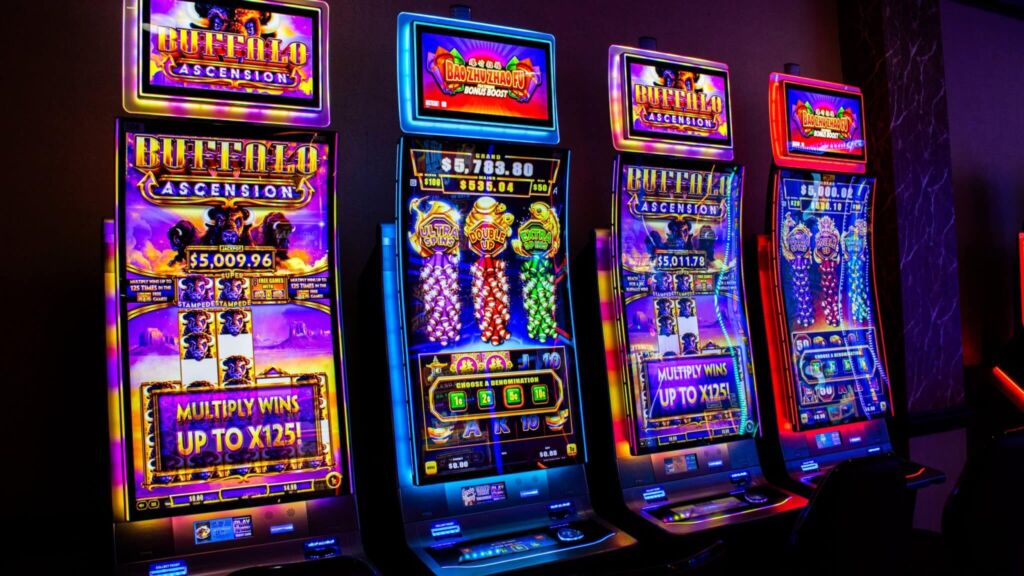The irresistible charm of slot machines , whether in physical locations or online, is hard to ignore. These games captivate millions globally with their simple yet intricate elements, including visuals and sounds, which deeply affect how players interact with them.
From the Early Days to Today: The Transformation of Slot Machine Graphics
Slot machine graphics have undergone a remarkable transformation, evolving from basic mechanical devices into today's engaging digital formats. Originally created in the late 1800s, these machines were engineering marvels, comprising physical reels adorned with basic symbols like fruit and bells. Their appeal lay in the kinetic action of spinning reels and the anticipation of a win, even with straightforward visuals that clearly displayed winning lines and rewards.
The 1960s brought a transformative era with electromechanical slots, leading to more intriguing visual displays. These early slots incorporated lights and rudimentary animations, enhancing the emotional experience of winning. However, the real game-changer came with video slots toward the end of the 20th century. By replacing mechanical reels with digital screens, game designers gained vast creative freedom to incorporate intricate themes and animations, transforming slot machines into a multimedia experience.
Today's video slots boast sharp graphics, vibrant palettes, and 3D animations that transport players into extensively crafted virtual environments. Themes vary widely, from ancient tales and mythical creatures to blockbuster movies and TV shows, each portrayed with unique artistic styles. This visual depth isn't merely about aesthetics; it’s crafted to enhance the sense of engagement, submerge players into the game world, and make the experience emotionally enriching. The refined graphics of modern slots play a vital role in drawing and keeping players, significantly contributing to the expansive slot industry. Visual appeal has moved far beyond the mere function of its mechanical predecessors, becoming a central attraction in slot machines.
The Audio Realm of Slot Machines: Crafting Thrill and Depth Through Sound
Sound is just as essential as graphics in defining the slot machine experience, often subconsciously shaping how players feel and act. The sound landscape of a slot machine is carefully curated, from the initial pleasant tones greeting players to the joyous melodies that accompany a large win. Traditional mechanical slots emitted basic noises – the rattle of reels, the click of mechanical parts, and the clink of coins. These naturally occurring sounds became closely associated with playing and winning.
As slots transitioned into the digital age, sound design advanced significantly. With digital sound technology, developers crafted elaborate soundscapes featuring nuanced sound effects, musical compositions, and voiceovers, making the auditory experience match the visual themes. Modern slot machines employ a multitude of sounds to enrich various gameplay elements. Background music and ambiance set the atmosphere, immersing players into a game's narrative. The spinning reel sounds, even in digital forms, are designed to evoke the familiar tactile response of physical reels, maintaining a connection to traditional experiences. Crucially, the sounds celebrating wins are specifically designed to be rewarding. These auditory elements often include melodic rings, triumphant tunes, and the delightful jangle of coins, all engineered to trigger a dopamine surge, reinforcing the enjoyment of wins and motivating continued play. Research into auditory perception and gambling suggests near-miss sounds and slight win cues are deliberately used to keep players engaged, instilling anticipation and the illusion of a potential win, which can be as influential as actual wins in promoting continued play. The adept use of sound in modern slots is a profound tool for emotional involvement and behavior encouragement.
Psychological Effects: How Graphics and Sound Attract and Engage
The psychological influence of graphics and sound in slot machines runs deep, carefully crafted to keep players attached and encourage prolonged playing sessions. Graphics are the first element to capture a player's attention with their bright colors, lively animations, and familiar themes. Human brains are naturally drawn to striking visual content, and slot machines leverage this tendency to create an immediately attractive experience. The use of well-known themes, pulled from popular movies or notable cultural icons, taps into established emotional connections, making the game appealing and relatable. Animations and visual effects serve a dual purpose, not only appealing aesthetically but providing continuous feedback, engaging players in the ongoing action even when spins don't result in a win. These visuals, combined with near-win instances, maintain a sense of suspense and the illusion of being close to a win.
Sound complements the graphics in reinforcing psychological engagement. Winning sounds powerfully activate the brain's reward systems, releasing dopamine, the chemical tied to pleasure and motivation. This leads to a positive loop, where playing is associated with joy, spurring more play. Sounds linked to almost wins or small victories hold psychological weight too. Often, these sounds echo but slightly differ from the big win tunes, crafting an auditory puzzle that the brain often misinterprets as signs of more wins ahead. This impression of being inches from a win, enhanced by sound, can be more effective in keeping a player engaged than actual small victories, as it touches on the gambler's hopefulness and belief that a big win edges closer. Together, stimulating graphics and rewarding sounds create a captivating and profoundly engaging experience, fuelling the addictive essence of slot machines.
The Role of Graphics and Sound in the Gambler's Mind: A Peek into Neuroscience
Neuroscience provides important insights into the effect of graphics and sound on the gambler’s brain, highlighting why slot machines are so captivating and potentially addictive. Imaging studies using fMRI and EEG scans reveal that slots activate significant reward pathways in the brain, particularly targeting the mesolimbic dopamine system. This system manages pleasure, motivation, and the learning from reinforcement. When a player sees winning combos or nearly wins, these reward systems trigger, releasing dopamine and sparking joy and anticipation.
Graphics are a key element in visually rousing these reward circuits. The rapid animations, bright lights, and colorful images characteristic of modern slots are made to grab attention and increase excitement in the brain. Sound effects further lift these sensations. Specifically, the sounds tied to wins prompt strong dopamine reactions. The auditory portion of the brain processes these uplifting sounds and relays signals to the reward centers, solidifying gambling behaviors. Research notes that even the desire for these sounds, incited by visual triggers or game sequences, can set off the reward mechanisms, creating a conditioned reaction propelling further play. Near-miss sounds, slightly different from winning sounds yet hinting at success, can evoke a level of neural excitement similar to achieving a small win, further blurring the boundaries between winning and losing in a gambler’s perspective. These insights from neuroscience underscore how intricately designed visuals and sounds in slot machines directly engage the brain's reward systems, contributing to the enthralling and sometimes addictive nature of these games. Grasping these neurological principles is crucial in crafting responsible gaming policies and interventions.
Contemporary Slot Machine Design: Engaging Experiences and Tailored Player Interactions
Today’s slot machines are designed to pull players into a world of engaging and personalized gaming, thanks to cutting-edge visuals and audio technology. Developers strive to go beyond just spinning reels; they infuse stories, interactive bonuses, and features that make gameplay more entertaining and social. High-quality graphics and animations are standard, creating breathtaking gaming environments. The variety of themes is extensive, from movie-like adventures to imaginary realms, each crafted with great artistry. The incorporation of famous franchises and IPs, like blockbuster films and popular TV series, adds to the immersive experience, drawing in fans who already love these cultural staples.
Modern slot machines boast intricate sound designs that enhance the gaming experience with multi-layered sounds, spatial effects, and dynamic tunes that change with the game’s progress. Players are increasingly able to personalize their audio experience, choosing from customizable sound settings. Unique sights and sounds mark interactive bonus rounds, offering exciting moments beyond the main game. Some slots even include voiceovers and character conversations, enriching the narrative and drawing players further into the game. Multiplayer tournaments and community jackpots are also becoming staples, adding a layer of social interaction and competition that enhances the gaming experience. These trends indicate a shift towards creating comprehensive entertainment that appeals to diverse player interests and boosts engagement through sophisticated sensory technology.
The Evolution of Slot Machine Aesthetics: Upcoming Trends and Innovations
As technology advances and players’ desires evolve, we can expect continued innovation in slot machine aesthetics. One exciting development is the use of Virtual and Augmented Reality (VR and AR) technologies, which could completely transform how gamers enjoy slots. VR could create entire virtual casino environments, offering interactive and lifelike gameplay experiences. Meanwhile, AR might blend digital game components with real-life settings. Haptic technology, which provides physical sensations like vibrations, is also gaining popularity, making players feel the reels' spinning or wins at their fingertips, thereby enhancing immersion.
Customization will play a central role in future slot machines. By leveraging artificial intelligence, games could immediately adjust graphics, audio, and even mechanics based on individual player preferences, delivering a tailor-made gaming experience. Future soundscapes may also evolve, reacting to players’ actions and emotions, to provide a more engaging auditory setting. Multiplayer modes, social ranking boards, and shared virtual spaces are expected to become more embedded, allowing for greater player interaction and competition. These coming advancements suggest a slot machine experience that is not only visually striking and aurally rich but also deeply personalized and interactive, closely blending gambling with immersive entertainment.
A Balanced Approach: Entertainment and Responsible Practices in Slot Machine Design
The role of graphics and sound in slot machines goes beyond mere visual appeal; these elements play a pivotal part in how players experience the game, influencing their perceptions and the overall enjoyment. Over time, slots have embraced more sophisticated visuals and soundscapes, capturing players' attention and drawing them deeply into the game. As slots become more exciting, it’s vital to acknowledge their potential impact on gambling behaviors, given that sensory stimuli like dopamine-inducing sounds and visuals can form strong loops that encourage continued play.
With cutting-edge trends like VR, AR, and bespoke gaming experiences on the horizon, the slot machine sector and regulators must continuously balance the thrill of engaging entertainment with the need for responsible gambling. Future designs should consider features that promote player consciousness and self-control, such as timers, spending caps, and reminders, alongside the engaging graphics and sounds that attract players. Ultimately, advancing slot machine designs responsibly requires careful consideration to ensure player safety without sacrificing entertainment.
External Resources:



